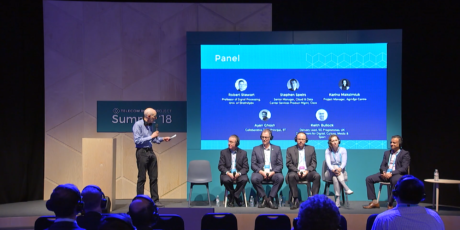
TIP Summit Panel Debate: Rural Connectivity Challenge Is Co-Innovation In Action
The TIP Summit has grown rapidly since its inception to become an important date in the telecom industry’s calendar. TIP has done an impressive job of bringing focus on “connecting the unconnected”, an area that challenges the entire telecoms industry and most governments across the world. This year’s event, held at London’s ExCel centre, provided an opportunity for industry leaders to come together in the spirit of collaboration. And our 5G RuralFirst project was on the agenda!
I was joined on this panel debate moderated by Robert Pepper, Head of Global Connectivity Policy and Planning at Facebook, alongside some of our key consortium partners across the 5G RuralFirst project. You can view the video recording of the event here:
It’s clear that government recognises the need to consider different models for rolling out 5G – not just from a rural perspective, but across the board. In the UK, the UK Government’s Department for Digital, Culture, Media and Sport (DCMS) has put in place an ambitious program to accelerate 5G rollout, and are (part) funders of the 5G RuralFirst project and five other UK testbed and trial projects.
Keith Bullock, Delivery Lead for 5G Programmes at DCMS outlined the 5G trial investment strategy, which supports Government’s Industrial Strategy. Keith explained how this was being used to complement the traditional connectivity strategy to change the economics, and therefore the outcomes.
“We went to the market – the universities, the tech companies and the local authorities and said, ‘what do you need?’. And we selected the most interesting, challenging and radical options – of which 5G RuralFirst was one.”
From a Cisco perspective the government funding support is fantastic, but the real value is in getting a number of companies together to co-innovate on a project.
What are the use cases for 5G in a rural setting?
In the 5G RuralFirst project we are looking at lots of applications across agri-tech, aquaculture, renewable energy, broadcast, industrial IoT and the local community. Karina Maksimiuk, Project Manager at the Agri-EPI Centre picked up the story at TIP Summit.
“There’s a new generation of farmers who want to use new technology to make farms more productive, so connectivity is front of mind for farmers”, she said.
“With 5G connectivity, we can make connectivity more ubiquitous utilising low latency. Dairy farming is very easy to quantify. If you’re tracking an animal’s health – for example, fertility – it’s been a very manual process up until now.
“Instead of having to go in and inspect the cow five or six times a day, it can be done remotely by fitting a collar to the animal. It frees the farmer’s time to be more productive elsewhere,” she explained.
Our 5G RuralFirst colleague Duncan Forbes from the Kingshay has written more on this over at the 5G RuralFirst blog.
If you consider rural Scotland, two of the biggest industries are salmon farming and whisky. Combined, they represent £1.7 billion in UK exports every year and represent not only Scotland’s but also the UK’s biggest food and drink exports, respectively. But these industries are constrained in how they can apply some of the latest productivity technologies for their industry, and don’t have the connectivity support they need.
As I said at TIP, we need to look at the business model differently. You can’t just continue to sell data packages. With 5G we need to think about vertical industry aligned and differentiated services for low latency and IoT.
As Bob Stewart, Professor for Signal Processing at the University of Strathclyde said, a big part of the conversation is about spectrum. “We’re not saying we advocate a ‘use it or lose it’ model for spectrum allocation, but ‘use it or share it’. That’s why we’re testing dynamic spectrum sharing to explore this in more detail. There’s an opportunity for community networks. To make this work, running one of these networks needs to be much easier than it is for the MNOs”.
“It’s not to say that the MNOs are not doing a great job. They are in so many ways. We hope to demonstrate that with a little bit of creativity and co-operation, we can provide new solutions.”
https://twitter.com/CiscoUKI/status/1052530579458183169
Economic Small Cell Deployment: With Facebook/TIP Technology
We also had significant discussion, led by Ayan Ghosh of BT Labs, on 5G RuralFirst’s trial of innovative Facebook TIP/OpenCellular economic small cells. Facebook in particular are keen to see live trials of OpenCellular technologies and the 5G RuralFirst project team is delighted to be able to offer Facebook/TIP the ambitious Orkney testbed for that purpose.
Project partner BT is leading one key 5G RuralFirst use case, deploying and testing small‐cell coverage solutions to explore how lower‐cost open cellular wireless platforms may make business models for deployment by rural communities more viable. This use case will make use of a disaggregated radio access solution with small‐cell radios from Accelleran, who we invited to be a 5G RuralFirst “Associate Partner”. At the time of writing, integration with the Cisco 5G core and inter‐operability testing has been successfully completed, using an internal Cisco lab with a fully operational core network, in advance of the Cisco 5G core being deployed at DataVita’s Tier III data centre in Central Scotland.
Discussing what appealed to BT about this technology, Ayan commented: “Facebook OpenCellular is a completely disaggregated small cell solution, so is very different to vendors we currently use in our 4G network. We’re looking at new business models and new cost models.”
Ayan continued “How can we have network coverage, deployed by locals, and run by locals. That’s what this particular 5G RuralFirst use case is about”.
In our case, CloudNet Solutions of Orkney will install this new generation equipment. This will deliver 4G services to the “not spot” area of East Mainland, Orkney’s biggest island, in the Deerness area. This will be connected to the main BT network via the Cisco 5G core, with internet connectivity all that is required to connect this 4G solution, genuinely enabling local communities to – literally – “bring their own network”.
Scalability and replicability
The panel asked about how we take the learnings from innovation projects like this and turn them into scalable, replicable applications.
Keith said, “Industry said to us that if you want to make a difference, you’ve got to do it at scale. We’ve just announced an urban connected communities project and there’ll be a sister project for connecting rural projects that we’ll be announcing soon. That will build on the learnings of the phase one projects like 5G RuralFirst to do some of these things at scale.”
Karina added, “We build solutions that we want to scale, not only in the UK, but internationally. Projects like this give us the ability to validate and then build it out.”
The community ecosystem point is an important one. If it wasn’t for the engagement we’ve had from local communities Orkney Council, and the likes of the wind farms, salmon farms and Orkney-based ISP CloudNet Solutions, we wouldn’t be able to make these projects work.
You wouldn’t ordinarily see these organisations working with universities, big tech vendors like Cisco, BT and Parallel Wireless, smaller companies like DataVita, Zeetta Networks and Soil Essentials, and government. For sure, it’s an excellent example of Cisco’s co-innovation strategy in action.
And after all, that’s what TIP Summit is all about: working with others with shared goals in mind.
To find out more about Cisco’s involvement in 5G RuralFirst, check out our latest episode of MACRO, the Cisco innovation podcast, anywhere you get your podcasts.



